
Girolamo Rainaldi was an Italian architect who worked mainly in a conservative Mannerist style, often with collaborating architects. He was a successful competitor of Bernini. His son, Carlo Rainaldi, became an even more notable, more fully Baroque architect.

Sant'Ambrogio e Carlo al Corso is a basilica church in Rome, Italy, facing onto the central part of the Via del Corso. The apse of the church faces across the street, the Mausoleum of Augustus on Via di Ripetta.

San Francesco a Ripa is a church in Rome, Italy. It is dedicated to Francis of Assisi who once stayed at the adjacent convent. The term Ripa refers to the nearby riverbank of the Tiber.

Ludovica Albertoni was an Italian Roman Catholic noblewoman from the Renaissance period and a professed member of the Third Order of Saint Francis. The death of her husband prompted her to dedicate her life to the service of the poor in Rome and she was also known for her ecstatic experiences.

Santa Maria dei Miracoli and Santa Maria di Montesanto are two churches in Rome.

Santa Francesca Romana, previously known as Santa Maria Nova, is a Catholic church situated next to the Roman Forum in the rione Campitelli in Rome, Italy.

Blessed Ludovica Albertoni is a funerary monument by the Italian Baroque artist Gian Lorenzo Bernini. The Trastevere sculpture is located in the specially designed Altieri Chapel in the Church of San Francesco a Ripa in Rome, Italy. Bernini started the project in 1671, but his work on two other major works—The Tomb of Pope Alexander VII and the Altar of the Blessed Sacrament in St. Peter's Basilica—delayed his work on the funerary monument. Bernini completed the sculpture in 1674; it was installed by 31 August 1674.
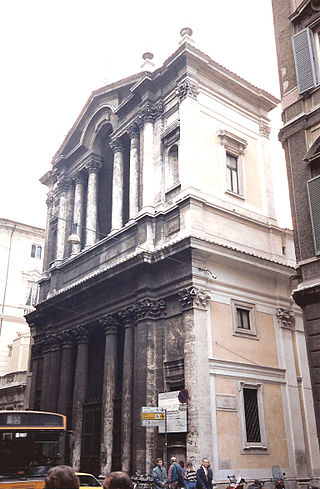
Santa Maria in Via Lata is a church on the Via del Corso, in Rome, Italy. It stands diagonal from the church of San Marcello al Corso. It is the stational church for Tuesday in the fifth week of lent.
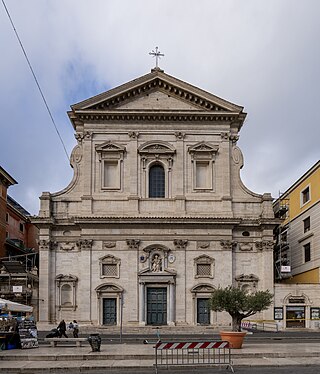
The Church of Santa Maria del Carmelo in Traspontina is a Roman Catholic titular church in Rome, run by the Carmelites. The bridge referred to is the Ponte Sant'Angelo. The church is on the Via della Conciliazione, the primary road of the Roman Rione of Borgo.

Santa Maria della Scala is a titular church in Rome, Italy, located in the Trastevere rione. It is served by friars of the Discalced Carmelite Order. Cardinal Ernest Simoni took possession of the titular church on 11 February 2017.
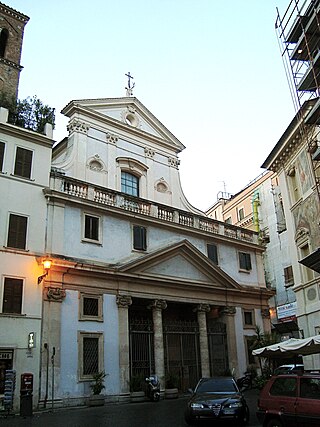
Sant'Eustachio is a Roman Catholic titular church and minor basilica in Rome, named for the martyr Saint Eustace. It is located on Via di Sant'Eustachio in the rione Sant'Eustachio, a block west of the Pantheon and via della Rotonda, and a block east of Sant'Ivo alla Sapienza and the Via della Dogana Vecchia.
Giovanni Antonio de' Rossi (1616–1695) was an Italian architect of the Baroque period, active mainly in Rome.

Mattia de Rossi was an Italian architect of the Baroque period, active mainly in Rome and surrounding towns.
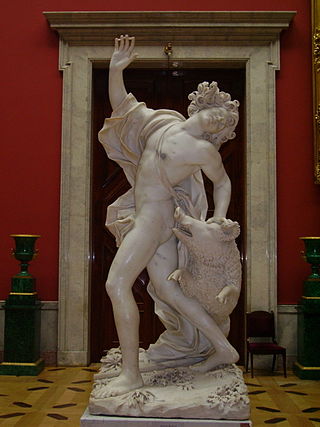
Giuseppe Mazzuoli was an Italian sculptor working in Rome in the Bernini-derived Baroque style. He produced many highly accomplished sculptures of up to monumental scale but was never a leading figure in the Roman art world.

Paluzzo Paluzzi Altieri degli Albertoni was an Italian Catholic Cardinal and Cardinal-Nephew to Pope Clement X.

Gesù e Maria is a Baroque church located on Via del Corso in the Rione Campo Marzio of central Rome, Italy. It faces across the street the similarly Baroque facade of San Giacomo in Augusta.
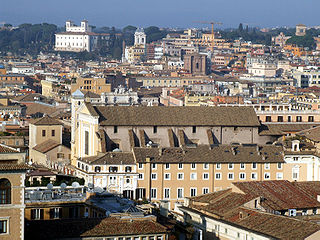
Santi Dodici Apostoli, commonly known as Santi Apostoli, is a 6th-century Catholic parish and titular church and minor basilica in Rome, Italy, the mother church of the Conventual Franciscan Order whose General Curia is in the adjacent building. Dedicated originally to St. James and St. Philip whose relics are kept here, and later to all Apostles, it is the Station church for Friday, the first week of Lent.
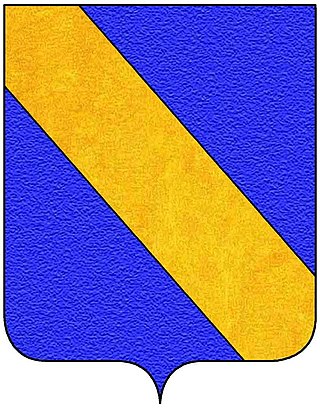
The Capizucchi family was a noble Roman family. Considered one among the oldest families in Rome, it was deeply rooted in the Roman nobility because of the gallantry of many members. The family died out in the 17th century, and its name came to an end in 1813. The Capizucchis had their homes in Campitelli rione, at the foot of Capitoline Hill, and there also lay their palace. This still exists and is located between two squares, Piazza Campitelli and the one that took its name from the family, Piazza Capizucchi.

The Albertoni Spinola Palace, with entrances in Campitelli square n. 2, Capizucchi square and vicolo Capizucchi is located in the 10th District. It was projected and executed by Giacomo Della Porta and Girolamo Rainaldi around the end of 16th century and the first years of 17th century.

The church of Santa Galla was a church in Rome (Italy), in the Rione Ripa, on the road that connected Piazza Montanara with Piazza della Bocca della Verità. Both the church and the square in front of it were destroyed between 1928 and 1930 for the construction of the first stretch of Via del Mare ; the furnishings and the altar were relocated to the new church of Santa Galla at Garbatella, built in 1940.

























